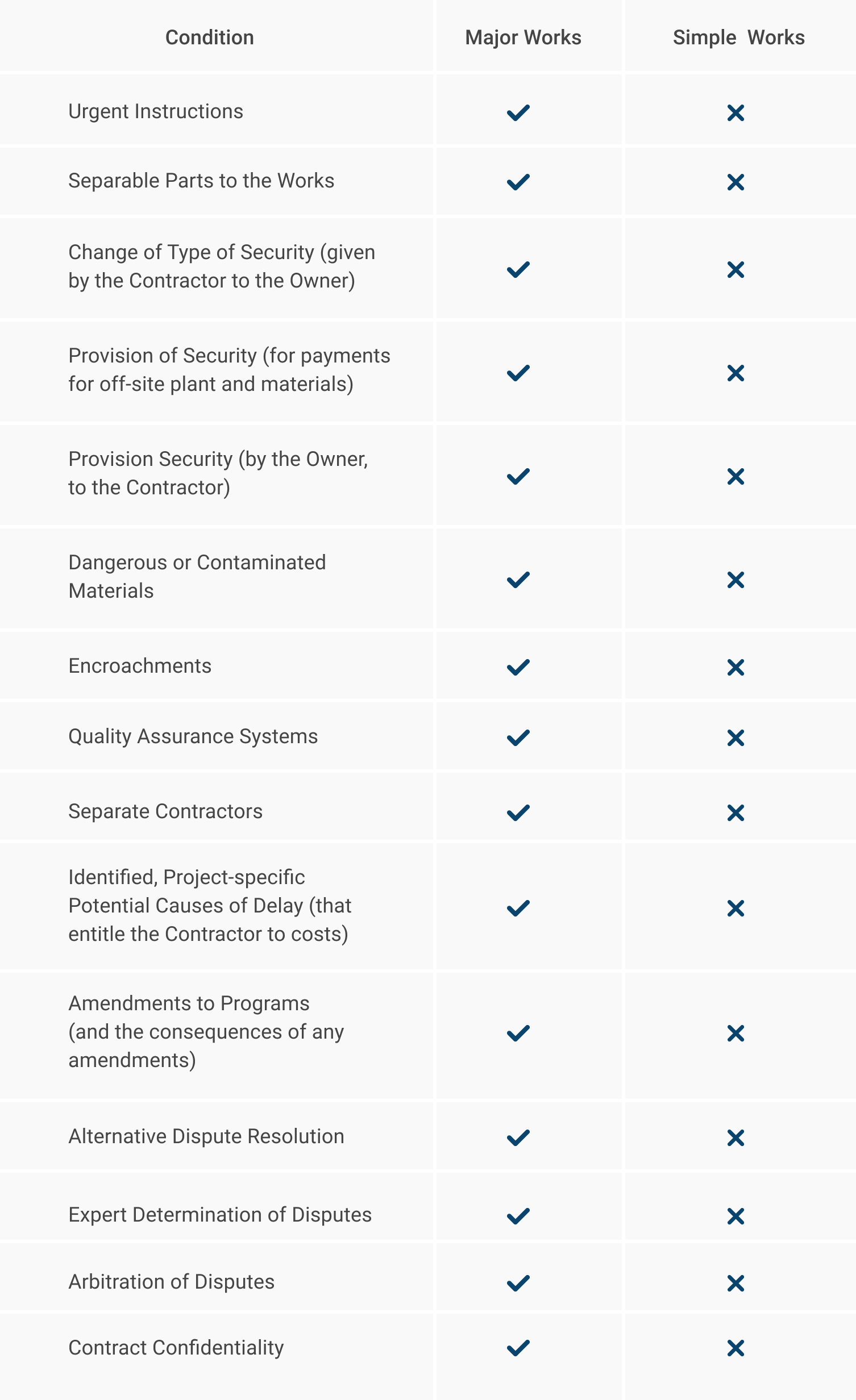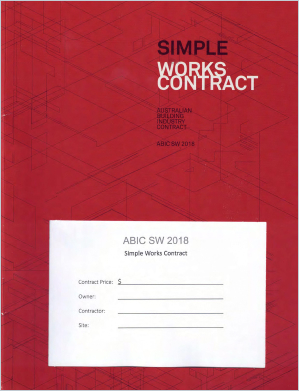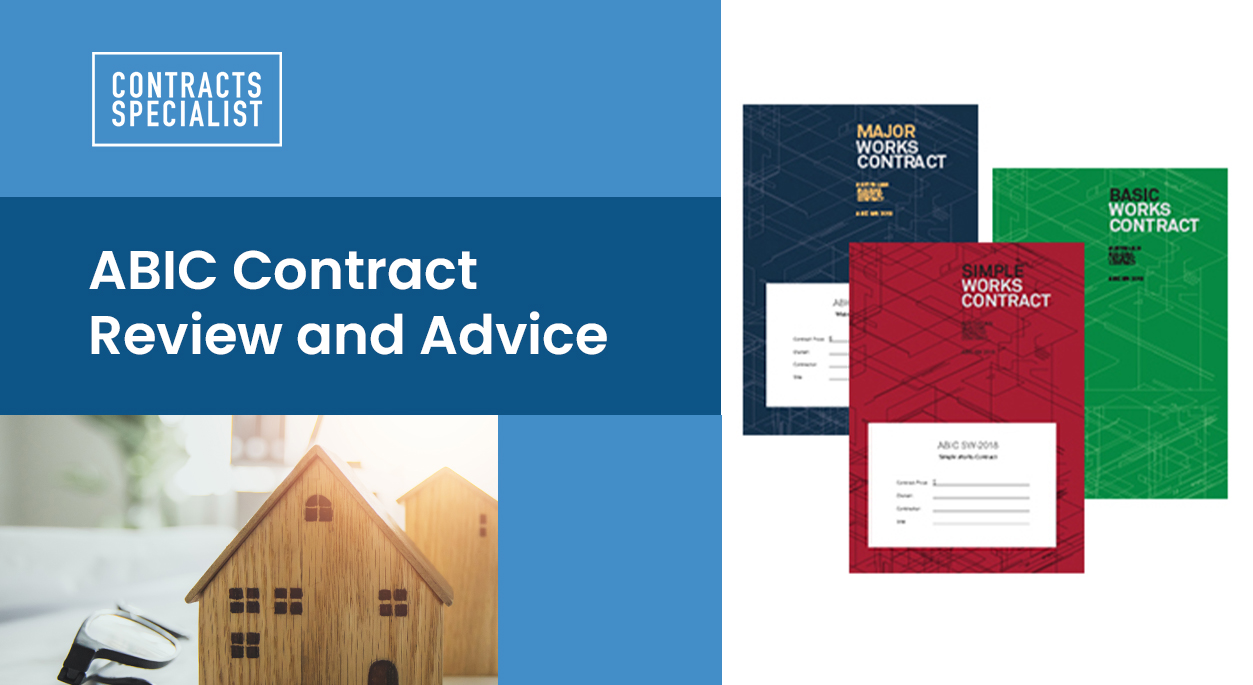ABIC Contracts at a Glance
ABIC Contracts is pivotal in the Australian building industry These contracts are designed specifically for members of the Australian Institute of Architects, who act as the superintendent of the contract in a construction project. Compared to other types of contracts, ABIC contracts are more detailed, yet still friendly to homeowners. They also allow for commercial arrangements that are not commonly found in other contracts such as HIA and MBA contracts.
ABIC Contracts are important as they provide a clear and concise framework for the legal rights and obligations of the parties involved in a construction project.
Get Expert Construction Contract Review and Advice
Get Your ABIC Contract Reviewed Now
Step 1: Simply fill out this form and upload your contract.
Step 2: We’ll review it and return to you with a fixed fee quote.
Minimise construction risks on cost, time, and quality.
Get Home Building Contract Review and Advice now.
What are the Australian Building Industry Contracts (ABIC)?
One of the benefits of using ABIC contracts in NSW is that they are more detailed than contracts issued by the Office of Fair Trading, while still being user-friendly for homeowners. These contracts allow for a range of commercial arrangements that are not typically found in HIA and MBA contracts, providing more flexibility for the parties involved.
ABIC contracts are suitable for a range of building projects, including commercial, residential, and public works. They are particularly useful for projects where an architect is involved in administering the contract, as they provide a clear framework for the parties to work within. For example, ABIC contracts may be suitable for a residential renovation project where the homeowner engages an architect to design and oversee the project, or for a commercial development project where the developer engages an architect to manage the construction process.
Types of ABIC Contracts
ABIC contracts offer a range of contract types for building projects that are administered by an architect. Understanding the different types of contracts available can help homeowners and builders to choose the right one for their project.
The most common types of ABIC contracts include Major Works, Simple Works, Commercial Costs Plus, Early Works, and Basic Works.
- Major Works contracts are designed for larger and more complex projects.
- Simple Works contracts are better suited for smaller and simpler projects.
- Commercial Costs Plus contracts are used for projects where costs are difficult to estimate.
- Early Works contracts are intended for projects that are in the planning or design phase.
- Basic Works contracts are designed for very small projects or for use as a subcontract for a larger project.
Each type of ABIC contract has its own set of rules and requirements, and it is important to choose the right one for your project to ensure that it is completed successfully. For example, a Major Works contract might be best suited for a large commercial development or public building project, while a Simple Works contract might be more appropriate for a residential renovation or addition.
By understanding the different types of ABIC contracts and their suitability for different projects, homeowners and builders can ensure that their projects are completed on time, within budget, and to a high standard.
Major Works vs. Simple Works
ABIC Contracts offer two main types of contracts: Major Works and Simple Works.
The Major Works contract is suitable for larger building projects, typically those with a budget over $3 million, while the Simple Works contract is ideal for smaller projects such as residential renovations, extensions or alterations.
| Major Works | Simple Works |
| For complex or large projects worth above $3,000,000 | For smaller projects worth between $500,000 – $3,000,000 |
The Major Works contract contains more detailed clauses and provisions than the Simple Works contract. It includes more specific requirements such as quality control, reporting and management of the works, and is generally considered to be more comprehensive. The Simple Works contract is a more streamlined version of the Major Works contract, with fewer provisions and clauses.

When deciding which contract to use, it is important to consider the size, complexity and budget of the project. Major Works contracts are more suitable for large-scale projects that require a higher level of detail and supervision, while Simple Works contracts are more appropriate for smaller projects where the requirements are less complex. It is also essential to consider the legal and financial risks associated with each contract and ensure that they are appropriately addressed in the contract documentation.
Related Content: ABIC Major Works Contract
Streamline ABIC NSW Contract Management with Home Building App
Navigating ABIC NSW Contracts requires precision and clarity. Home Building App (HBApp) is the perfect tool for homeowners dealing with these contracts. HBA simplifies the complexities of contract administration, ensuring effective management and compliance.
Key Features and Benefits of HBApp for ABIC NSW Contracts
- Efficient Document Organisation: Organise and manage all your ABIC contract documents efficiently with HBApp’s document organisation feature.
- Streamlined Communication: Maintain clear communication channels with all stakeholders, essential in managing ABIC contracts effectively.
- Task Allocation and Tracking: Assign and monitor tasks related to contract review and drafting, ensuring all contract specifics are addressed accurately and timely.
Simple Works - Housing

A Simple Works contract would be best for housing projects because it is brief but still prescriptive enough to cover the main issues. It’s short and basic, but still covers all the bases.
The parties to a Simple Works – Housing contract are:
administers the contract
undertakes the work
client who requests the work to be done
Below are the conditions included in a Simple Works Contract for Housing in NSW:
Section A: Overview
Purpose: Sets out the obligations and warranties of the Architect and the Contractor, and how the Architect, Contractor, and Home Owner will work together.
Includes:
- Cooperative contracting
- Obligations of the contractor
- Warranties by the contractor
- Obligations of the owner
- Warranties by the owner
- Architect to administer contract
- Architect’s instruction
- Disputing architect’s certificate or written decision
- Disputing architect’s failure to act
- Failure to give certificate, written decision or notice is not acceptance
- Compensation is sole remedy
Section B: Documents
Purpose: Sets out the parties obligations to supply documents, and their recourse should there be discrepancies or conflict.
Includes:
- Discrepancies or omissions in documents
- Order of precedence of documents
- Contractor and owner must supply copies of official documents
Section C: Security
Purpose: Sets out the parties’s securities and release of security.
Includes:
- Security provided to owner
- Security to owner by cash retention
- Security to owner by unconditional guarantees
- Owner’s right to draw on security provided to it
- Procedure for owner to draw on security provided to it
- Owner’s release of security on practical completion
- Owner’s release of security on final certificate
Section D: Liability
Purpose: Sets out the parties’ liabilities, risks, and indemnities before and after practical completion. One of the most common issues with works is with building defects so the parties are encouraged to take photos and be sticky with emailing their findings.
Includes:
- Risk before practical completion
- Indemnity before practical completion
- Risk after practical completion
- Indemnity after practical completion
- Reinstatement during period when contractor bears risk
Section E: Insurance
Purpose: Sets out the insurance requirements and details about payment of claims.
Includes:
- Public liability insurance
- Contract works insurance
- Entitlement to input tax credit
- Insurance cover
- Limited right to arrange insurances
- Contractor and owner not to affect insurance
- Worker’s compensation and employer’s liability insurances
- Insurance claims
- Payment of excess
- Contractor entitled to make progress claim as result of loss or damage
- Warranty insurance
Section F: The site
Purpose: Sets out who can access the site and how, as well as the parties’ obligations on site.
Includes:
- Owner to give contractor possession of the site
- Contractors obligations in relation to the site
- Owner warrants that it has given the contractor the site information
- Contractor to examine the site information
- If contractor discovers a latent condition or valuable item
- Architect to instruct in relation to a latent condition or valuable item
- Contractor entitled to claim for latent condition or valuable item
Section G: Building the works
Purpose: Sets out the Contractor’s and Home Owner’s obligations, subcontracting, and how they will work together
Includes:
- Owner’s obligations
- Contractor’s obligations
- Contractor to appoint representative
- Subcontracting
- Contractor to give program to architect
- Contractor to give updated program
- Architect may instruct opening up or testing of the works
- Contractor entitled to claim for costs of opening up or testing
- When contractor entitled to unfixed or demolished materials
Section H: Claims to adjust the contract
Purpose: Sets out the procedure on how a claim to adjust the contract can be made
Includes:
- Time for making a claim to adjust the contract
- Details required for claim
- Architect to assess claim
- Architect to give assessment
- Sum recoverable for claim for adjustment of time costs
- Architect may adjust contract in absence of claim
Section J: Variation to the works
Purpose: Sets out the procedure for claiming variations and managing changes in the works. The parties are encouraged to maintain a variation register and all progress claims identify each of the registered variations.
Includes:
- Architect may instruct variation to the works
- Contractor to review instruction
- Architect to instruct whether variation is to proceed
- If contractor receives written instruction to proceed
- Adjustment to the contract after written instruction to proceed
- If authorised person issues official document
- Architect to give instruction
- Contractor entitled to make claim for official document
Section K: Adjustment of provisional sums and prime cost sums
Purpose: Sets out the provisional and prime cost sums, in addition to the contract price, and how they can be adjusted
Includes:
- Provisional and prime cost sums included in contract
- Architect may instruct regarding provisional or prime cost sum
- Architect may instruct contractor to use particular person for provisional or prime cost sum
- Adjustment for provisional or prime cost sum
Section L: Adjustment of time
Purpose: Sets out the procedure by which the parties can alter the schedule
Includes:
- Causes of delay which entitle making a claim for adjustment with costs
- Causes of delay which entitle making claim for adjustment of time without costs
- Contractor to notify of delay
- Contractor to allow for delays
- Adjustment of provisional allowance for delays
- Overlapping delays
Section M: Completion of the works
Purpose: Sets out the practical completion, defects relating to the works, and the liability period after practical completion
Includes:
- Practical completion
- Inspection by the contractor
- Notification to architect of practical completion
- Architect to decide if the works have reached practical completion
- If the works not at practical completion
- Contractor to bring the works to practical completion
- If architect fails to issue notice of practical completion
- Possession of the works before practical completion
- Liquidated damages may be payable
- Deduction of liquidated damages
- Contractor to correct defects and finalise work
- If the contractor fails to correct defects and finalise work
- Defects liability period
- Contractor’s obligations during and after defects liability period
Section N: Payment for the works
Purpose: Sets out the obligations of the parties regarding the contract price, progress claims, and final certificate. Progress claims must be assessed pursuant to this clause. The payments must comply with section 8A of the Home Building Act and be made when stages of works are achieved.
Includes:
- Contract price
- Owner’s obligation to pay contract price
- Stage payment claims – procedure for contractor
- Progress claims – procedure for architect
- Tax invoice
- Certificates – obligation to pay
- Before making first progress payment
- If architect fails to issue certificate
- Contractor entitled to make claim
- Final claim – procedure for contractor
- Final certificate – procedure for architect
- Final certificate – tax invoice
- Final certificate – obligation to pay
- Effect of final certificate
- Interest on overdue amounts
- Payment of deposit
- Time for assessing deposit
Section P: Dispute Resolution
Purpose: Sets out the process the parties are required to comply with should dispute arise. The parties must comply with the ABIC Contract dispute resolution procedure including where there are defects and delays with the works.
Includes:
- Each party must continue to perform its obligations
- Compulsory conference
- Mediation
- Legal rights
Section Q: Termination of engagement
Purpose: Sets out the parties’ rights and obligations concerning termination, and the procedure for effecting a valid termination.
Includes:
- Owner may require contractor to remedy default
- Owner may immediately terminate
- Owner may take possession of the site
- Assignment of contractor’s rights
- Owner may contract with others to complete the works
- Owner not bound to make any further payment to contractor
- Owner may pay subcontractor or suppliers
- Architect to give assessment of cost of completing the works
- Architect to give certificate of amount payable to contractor or owner
- Contractor or owner to pay under clause Q9
- Contractor may require owner to remedy default
- Contractor may suspend if default not remedied
- Contractor’s subsequent right to terminate
- Contractor may immediately terminate
- Contractor’s entitlement after termination
- Procedure for contractor to make claim
- Architect to give certificate
- Contractor or owner to pau under clause Q17
- If this contract is frustrated
Section R: Miscellaneous
Purpose: Sets out additional clauses.
Includes:
- Transmission of documents
- Time document is received
- Assignment
- Entire contract
- Contract to benefit successors and assignees
- Severability
- Waiver
- Governing law
- Compliance with law
- Change in relevant legislation
- Interpretation of headings
- Contractor and owner to observe confidentiality
- General interpretation
Section S: Definitions
Purpose: Lists the legal and/or technical and other terms used in the contract, and how they’re defined in the context of the contract.
Related Content: ABIC Simple Works Contract

How Our Expertise in ABIC Contracts Can Help You
As a solicitor and construction lawyer with over 10 years of experience in construction law, I specialise in advising homeowners and builders on their contractual and legal rights. I am well-versed in ABIC contracts and can help you review and understand the terms and conditions of your contract.

With my expertise, you can rest assured that your contract will be administered effectively, minimising the risk of disputes and legal issues down the line.
Ready to ensure a smooth and successful building project? Don’t wait any longer. Book a consultation with me or you can email us for tailored advice and discuss how I can assist you further.





